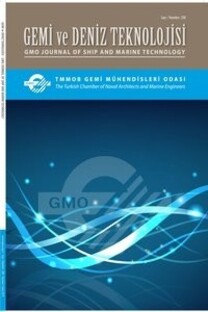Deniz Teknolojileri Mühendisliği Alanının Bibliyometrik Analizi
Bu çalışma, 1989-2021 Mayıs döneminde Ocean Engineering alanında yayın yapan dergilerdeki yayınları; araştırmacıların, kurumların ve dergilerin bu alana katkılarını zamanla değişimlerini dikkate alarak incelemektedir. Çalışma kapsamında Scopus veri tabanı kullanılarak toplam 292,755 adet Ocean Engineering alanı ya da bu alanla ilişkili alanlardaki yayınlar kapsamlı bir bibliyometrik yaklaşım ile analiz edilmiştir. Çalışmada analizler yayınların year, author(s), subject area, document type, keywords, affiliations, funding sponsor(s), country, source type, language, and citations of the publications bilgileri kullanılarak yapılmıştır. En fazla yayını 14,959 adet yayın ile Proceedings of the International Offshore and Polar Engineering Conference source yaparken, 1,298 adet yayın ile C. Guedes Soares yazarı yapmıştır. Ayrıca yazarların ve dergilerin Ocean Engineering alanında yayınladıkları yayınların makale başına aldıkları ortalama atıf değerleri de gösterilmiştir. Yayın başına en fazla atıf alan yazar 17.24 oranı ile Torgeir Moan olurken 33.24 oranı ile Coastal Engineering dergisi olduğu görülmüştür. Ayrıca bu alandaki yayınlarda en sık kullanılan 160 anahtar kelimeler de analiz edilmiş olup bu anahtar kelimeler 11 ana grupta tasnif edilmiştir. Bu alanda en fazla çalışılan konu 26% oranı ile Naval Architecture olduğu görülmüştür.
Anahtar Kelimeler:
Bibliyometrik Analiz, Gemi İnşaatı, Nümerik Analiz, oşinografi, off-shore Teknolojileri, Kıyı Mühendisliği, Çevre Mühendisliği, Enerji, Deniz Teknolojileri Mühendisliği, Gemi Makineleri Mühendisliği
Bibliometric Analysis for the Field of Ocean Engineering
This study examines the publications in journals published in the field of Ocean Engineering from 1889 to May 2021 by noting the contributions of researchers, institutions and journals to this field as well as the changes over time. A total of 292,755 publications in the field of Ocean Engineering and related fields have been analyzed in the study through a comprehensive bibliometric approach using the Scopus database. The analyses were performed using information such as the publications’ year, author(s), subject area, document type, keywords, affiliations, funding sponsor(s), country, source type, language, and citations. Proceedings of the International Offshore and Polar Engineering Conference is the most productive source with 14,959 publications. In addition, C. Guedes Soares is the most productive author in this field as an author with 1,298 publications. Also, the average number of citations per article for the articles authors and journals have made in the field of Ocean Engineering are also shown. Torgeir Moan is seen to receive the greatest number of citations per article at 17.24, while the most-cited journal is Coastal Engineering with a rate of 33.24. 160 of the most commonly used keywords in the publications in this field have also been analyzed and classified into 11 main group. The most studied topic in this field is seen to be Naval Architecture at a rate of 26%.
Keywords:
Bibliometric Analysis, Ocean Engineering, Naval Architecture, Marine Engineering, Numerical Methods, Oceanography, Offshore Technologies, Coastal Engineering, Environment Science, Energy,
___
- [1] Y. Zhang, K. Huang, Y. Yu, and B. Yang, “Mapping of water footprint research: A bibliometric analysis during 2006–2015,” J. Clean. Prod., vol. 149, pp. 70–79, 2017, doi: 10.1016/j.jclepro.2017.02.067.
- [2] Z. M. Sun and W. N. Hua, “A comparative study of Ocean Engineering research between China and the world,” Scientometrics, vol. 105, no. 1, pp. 51–63, 2015, doi: 10.1007/s11192-015-1670-y.
- [3] Z. H. Munim, M. Dushenko, V. J. Jimenez, M. H. Shakil, and M. Imset, “Big data and artificial intelligence in the maritime industry: a bibliometric review and future research directions,” Marit. Policy Manag., vol. 47, no. 5, pp. 577–597, 2020, doi: 10.1080/03088839.2020.1788731.
- [4] S. D. Meyers, L. Azevedo, and M. E. Luther, “A Scopus-based bibliometric study of maritime research involving the Automatic Identification System,” Transp. Res. Interdiscip. Perspect., vol. 10, no. May, p. 100387, 2021, doi: 10.1016/j.trip.2021.100387.
- [5] J. M. R. Camargo, M. V. B. Silva, A. V. F. Júnior, and T. C. M. Araújo, “Marine geohazards: A bibliometric-based review,” Geosci. Switz., vol. 9, no. 2, 2019, doi: 10.3390/geosciences9020100.
- [6] S. Zhong, Y. Geng, W. Liu, C. Gao, and W. Chen, “A bibliometric review on natural resource accounting during 1995–2014,” J. Clean. Prod., vol. 139, pp. 122–132, 2016, doi: 10.1016/j.jclepro.2016.08.039.
- [7] J. Sun, M. H. Wang, and Y. S. Ho, “A historical review and bibliometric analysis of research on estuary pollution,” Mar. Pollut. Bull., vol. 64, no. 1, pp. 13–21, 2012, doi: 10.1016/j.marpolbul.2011.10.034.
- [8] V. H. Pauna, E. Buonocore, M. Renzi, G. F. Russo, and P. P. Franzese, “The issue of microplastics in marine ecosystems: A bibliometric network analysis,” Mar. Pollut. Bull., vol. 149, no. August, p. 110612, 2019, doi: 10.1016/j.marpolbul.2019.110612.
- [9] M. Wu, Y. Jiang, R. W. M. Kwong, S. K. Brar, H. Zhong, and R. Ji, “How do humans recognize and face challenges of microplastic pollution in marine environments? A bibliometric analysis,” Environ. Pollut., vol. 280, p. 116959, 2021, doi: 10.1016/j.envpol.2021.116959.
- [10] J. Rumin, E. Nicolau, R. G. de Oliveira, C. Fuentes-Grünewald, K. J. Flynn, and L. Picot, “A bibliometric analysis of microalgae research in the world, Europe, and the European Atlantic area,” Mar. Drugs, vol. 18, no. 2, 2020, doi: 10.3390/md18020079.
- [11] J. Baas, M. Schotten, A. Plume, G. Côté, and R. Karimi, “Scopus as a curated, high-quality bibliometric data source for academic research in quantitative science studies,” p. 10.
- [12] “What is the complete list of Scopus Subject Areas and All Science Journal Classification Codes (ASJC)? - Scopus: Access and use Support Center.” https://service.elsevier.com/app/answers/detail/a_id/15181/supporthub/scopus/ (accessed Jun. 07, 2021).
- [13] U. Gunes, “Bibliometric Data,” Google Drive, Feb. 06, 2021. https://drive.google.com/drive/folders/1nii1MfQLUwy8TYFQK--CHnMgG7hbgFzE (accessed Jun. 07, 2021).
- [14] K. Toom, “Chapter 10 - Indicators,” in Research Management, J. Andersen, K. Toom, S. Poli, and P. F. Miller, Eds. Boston: Academic Press, 2018, pp. 213–230. doi: 10.1016/B978-0-12-805059-0.00010-9.
- [15] Elsevier, “Measuring a journals impact,” 2020. https://www.elsevier.com/authors/journal-authors/measuring-a-journals-impact (accessed Jun. 07, 2020).
- ISSN: 1300-1973
- Yayın Aralığı: Yılda 2 Sayı
- Başlangıç: 1955
- Yayıncı: TMMOB Gemi Mühendisleri Odası
Sayıdaki Diğer Makaleler
Satıhtaki Bir Denizaltının Yalpa Salınım Hareketinin Matematiksel Modeli
Deplasman Tipi Gemiler için Sayısal Analizlerin Gerçeklemesi ve Doğrulaması
Deniz Teknolojileri Mühendisliği Alanının Bibliyometrik Analizi
Bilyalı Dövme İşleminden sonra Ti6Al4V Alaşımının Tribolojik Özellikleri
19. Yüzyılın Sonlarında Osmanlı Devleti’nde Gemi Boya ve Kaplamaları
